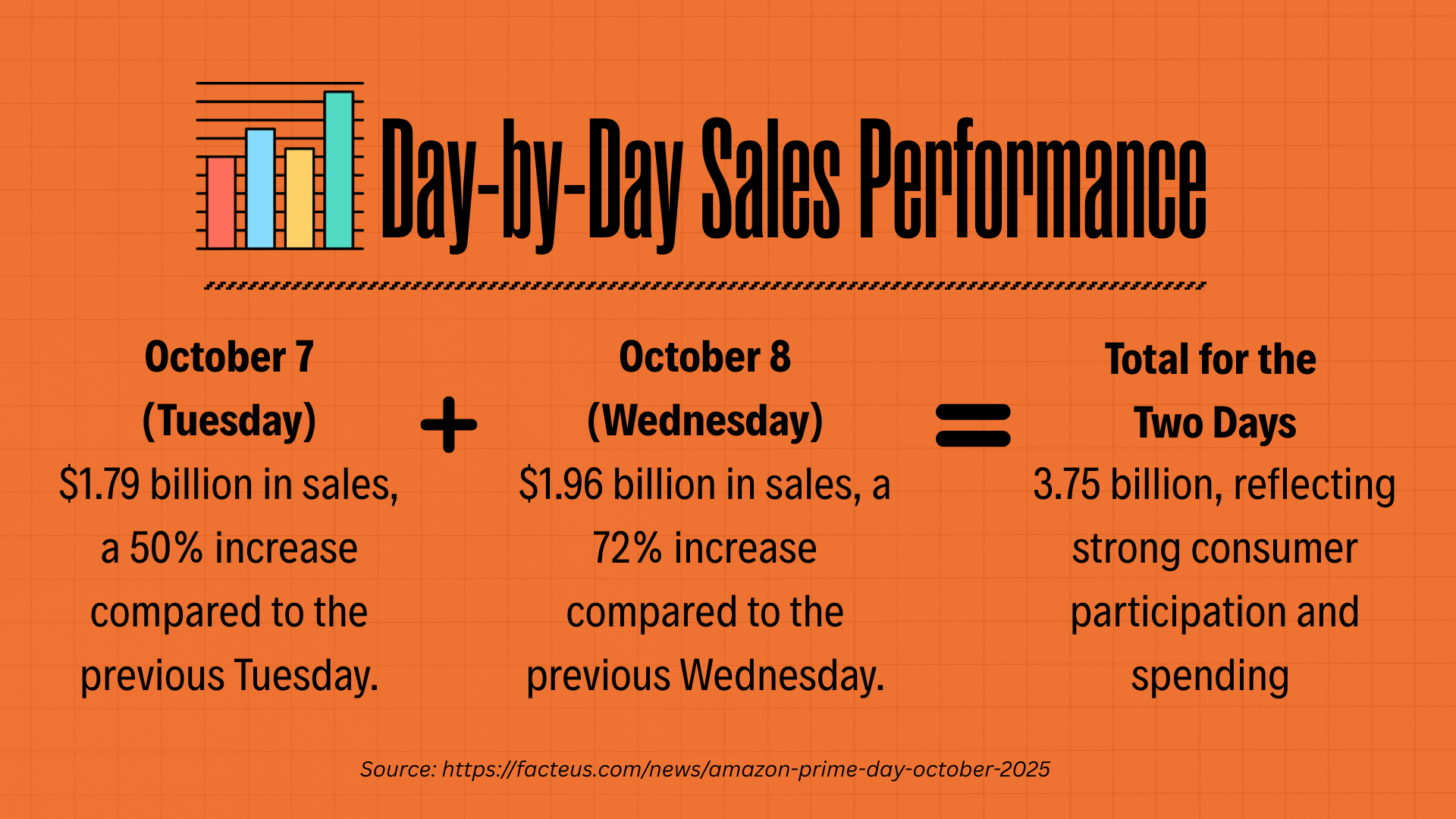2025 Fall Prime Report

I. Prime Day Sets the Tone for Q4
Prime Day may be over, but its ripple effects fuel your holiday wins.
Fall Prime Big Deal Days 2025 (Oct 7-8) kicked off early holiday shopping for essentials and gifts, offering a preview of what’s coming this Black Friday and Cyber Monday. This report serves as a temperature check for brand performance, consumer behavior, and Amazon ad trends as we head into Q4. Brands that take the time to analyze these trends now will be better positioned to outperform their competitors later in the season.
II. The State of Amazon This Fall
Data from Prime Day highlights shifting consumer priorities and spending behaviors that will influence Q4 performance.
For this year’s event, forecasts predicted a 7% year-over-year increase in GMV, marking it as the largest October Prime event so far. Consumers spent $3.75 billion during the two days, compared to $942 million from last year. The average order was $45.42, with 44% of orders under $20 and 90% under $100.
The top categories purchased in October included:
- Apparel & shoes (26%)
- Household essentials (26%)
- Beauty & cosmetics (22%)
- Health & wellness items (21%)
- Home goods (21%)
Consumer Behavior Insights:
- Only 23% of shoppers took advantage of Prime Big Deal Days for early holiday shopping (vs. 26% in 2024).
- Despite limited early adoption, 84% of Prime Day shoppers are likely to return for holiday purchases.
- Value-consciousness and inflation influenced spending; shoppers prioritized practical essentials over discretionary items.
According to a Numerator 2025 Prime Big Deal Days Survey:
- Nearly half (48%) of shoppers indicated that tariffs influenced their purchase decisions.
- 29% were more cautious due to the economic climate.
- 28% limited spending due to inflation or cost-of-living concerns.

III. Ad Strategy: Winning Tactics
Understanding what worked and what didn’t provides a playbook for Q4 ad strategy.
- Sponsored Brands & Video Ads: Campaigns using Sponsored Brands and Sponsored Display during Prime Day 2024 drove 47% higher sales than average category growth. Video placements above the Brand Store homepage fold improved product exploration.
- Budget Pacing & Timing: Brands using a front-loaded strategy for awareness in the first 48 hours, then switching to conversion tactics, performed better. Real-time budget optimization was also key; advertisers who monitored campaign pacing daily and adjusted spend saw improved results.
- Retargeting & DSP: Brands using Amazon DSP for retargeting, such as targeting users who viewed product pages or engaged with ads, successfully converted interest into sales post-event. New customers were more likely to convert in the event's latter half, showing successful retargeting.
- Bidding Behavior & CPC Trends: Despite Prime Day's competitiveness, CPC rates dropped by 10.4% in July 2025 compared to 2024, indicating more disciplined bidding for sustained visibility and efficient budget use.
IV. Operations & Inventory Watchouts
Here are key operational and inventory considerations for Prime Day:
- FBA Cutoff Dates & Delays: Monitor Amazon FBA cutoff dates and check-in delays to ensure timely inventory readiness.
- Inventory Forecasting: Forecast inventory based on Prime Day sales velocity to maintain optimal stock levels.
- Warehouse Capacity: Account for the impact of early deals on warehouse capacity to avoid storage issues.
- Out-of-Stock Penalties & Buy Box: Implement strategies to avoid out-of-stock penalties and maintain Buy Box eligibility.
VI. Lessons Learned: What Prime Day Tells Us About Q4 Success
Turn Prime Day learnings into unstoppable holiday season momentum.
- Budgeting: Avoid overspending early by staggering your spending throughout Cyber Week. This approach allows for better financial management and ensures you can capitalize on deals as they emerge, rather than exhausting your budget upfront.
- Creative Strategy: Refresh your ad copy and visuals now to capture attention and resonate with holiday shoppers. Emotional content tends to convert better in November, so focus on crafting messages that evoke feelings of warmth, nostalgia, and excitement.
- Inventory Planning: Plan for 1.5–2x your Prime Day velocity to meet the increased demand during Cyber Week. Adequate inventory ensures you can fulfill orders promptly and avoid losing potential sales due to stockouts.
- Retention & Remarketing: Leverage Prime Day traffic to build remarketing lists for future campaigns. Utilize data from your Prime Day traffic to create targeted lists based on user behavior and engagement, and then use these lists for remarketing efforts via DSP, email, or brand store engagement.

VII. Predictions for BFCM 2025
For Black Friday/Cyber Monday 2025, we anticipate strong performance in electronics, home goods, and beauty and wellness, with deals emphasizing discounts and bundles. Consumer behavior will likely reflect budget-conscious yet emotionally driven gifting, balancing value and personal connection.
Ad competitiveness is expected to intensify, with rising CPCs and a focus on strategic placement. Brands should prioritize data-driven strategies, personalized messaging, and efficient budget allocation to maximize ROI in a competitive landscape.
Want to see how your brand can win this BFCM?
Contact Straight Up Growth for a free audit and actionable insights to optimize your campaigns before the holiday rush.




